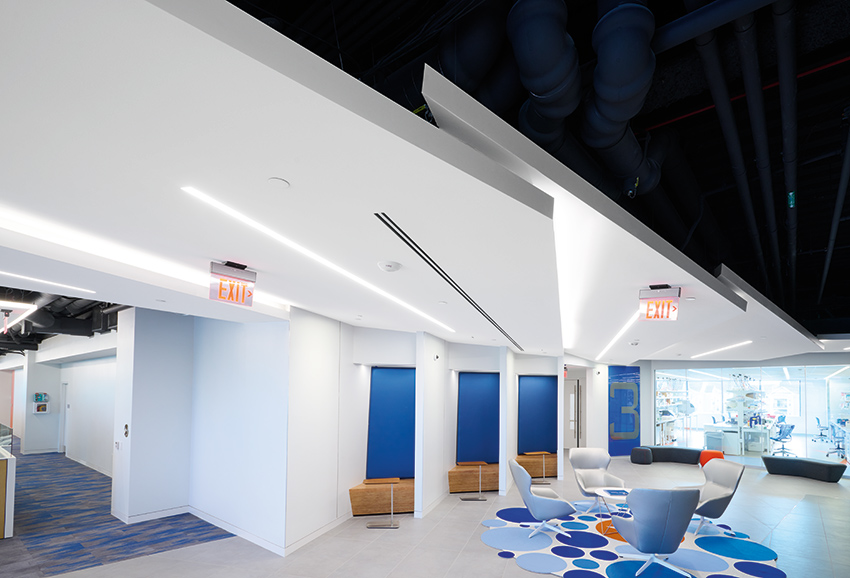Aesthetic Compatibility
White is the most common ceiling color for acoustical drywall alternative, however light color tones are available. There is not a lot of flexibility when it comes to darker colors. Design trends that use multiple materials for ceilings in single and adjoining spaces continue to be on the rise, and the acoustical drywall alternative is able to integrate with—and complement—materials such as wood, metal, and felt to provide the mixed-material aesthetic.
Seamless Integrations For Acoustical Ceiling Systems
Acoustical ceiling systems that have the smooth look of drywall can be integrated seamlessly with lighting and other features the same way as a drywall ceiling. They accommodate light fixtures, HVAC grille, floating trim, shade pockets, HVAC return air plenum, access doors, and transitions to standard acoustical ceiling systems. The system’s finish can be used to coat most GRG or metal access panels/doors in order to maintain a consistent finished-ceiling visual.
These pre-engineered, integrated solutions not only make specification easy but also allow fast and easy installation by removing the guesswork. The ceiling and components are specifically designed to work together as a system, yielding a variety of benefits.
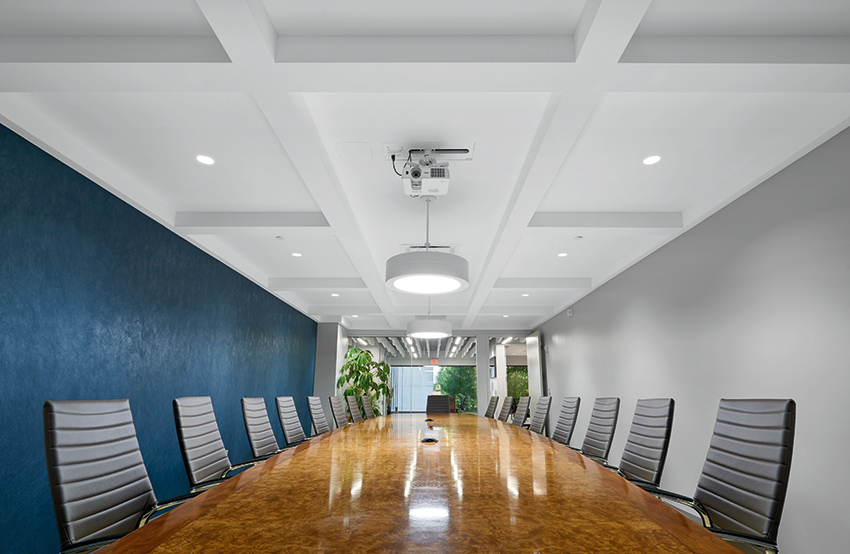
Photo courtesy of Armstrong Ceiling and Wall Solutions
Ceiling systems provide a first impression to anyone entering the room and can affect the way people experience their interactions with others inside the space.
Integration with Lighting Systems
The seamless acoustical drywall alternative integrates well with a variety of lighting systems, from energy efficient LED lighting to luminaires. For instance, it can integrate with lighting designs for high ceilings, zero plenum interference, and on-center continuous or noncontinuous linear lighting layouts.
These types of ceilings can be installed with most compatible light fixtures or diffusers, but it is still important to select those that will specifically integrate with the system. It’s crucial to select fixtures than can accommodate 7/8-inch-thick ceiling panels. Also of note: Excessive ceiling integrations and/or small enclosed spaces where the ceiling is more joint compound than open area will result in degradation of sound absorption.
Integration of In-Ceiling UV-C Air-Cleaning Systems
UV-C air-cleaning systems have become more popular and have seen more development over the past year and a half since the first U.S. shutdowns due to the pandemic in early 2020. As people return to work, systems that can proactively fight pathogens have become not just a stopgap between pandemic times and “normal” times, but a solution for the long term. Building owners must come to accept the idea that prevention is key and understand that technologies that can clean the air are now essential to help reduce the transmission of certain viruses, bacteria, and allergens.
Tests have proved that high-quality, UV-C air-cleaning technology reduces the transmission of certain viruses, bacteria, and allergens. In some cases, simulation studies have shown UV-C air-cleaning systems reduce bacteria by more than 20 percent and reduce inhaled particle concentration by 22 percent in comparison to rooms with no air filtration.
Acoustical drywall alternative ceiling systems integrate well with certain UV-C air-cleaning systems. Ceiling units can be concealed and installed out of the way. In tests, in-ceiling placement of air-cleaning technology outperforms air-cleaning units placed on the floor. In one simulation study, the in-ceiling unit reduced particle concentration by 14 percent more than traditional floor units.
Seismic and Other Movement Features
Seismic design is an essential part of the structural analysis when designing a building. Seismic design features can help preserve a building during and after it experiences an earthquake. It’s an aspect of design that has evolved over time and is now a basic component of integrated systems, including ceiling systems.
Drywall grid systems that support the seamless acoustical ceiling systems have been tested and are approved for use in seismic design categories D, E, and F. Seismic D corresponds to buildings and structures in areas expected to experience severe and destructive ground shaking, but not close to a fault. Seismic E refers to buildings in areas near major active faults. Seismic F corresponds to buildings of occupancy groups in hospitals, police stations, and emergency control centers near major active faults.
Seamless acoustical ceiling systems also integrate with control joints to help relieve stress induced by small movement from absorption or expulsion of moisture. Control joints are required and follow the same guidelines used for drywall in ASTM C480 Section 20. The ceiling systems integrate well with expansion joint systems, too, which are integral to seismic design and handle small and big impacts from movement from moisture to earthquake activity.
Access Doors
Plan for access doors just as with drywall or move the item that needs service access to another area that has acoustical ceiling tile so the item is accessible. Specifying clouds can also provide open access areas to the plenum between the clouds.
Soffits
One significant misperception about seamless acoustical ceilings is that they are more limiting than drywall in terms of options. In fact, these systems are capable of very complex soffit designs using a prefabricated soffit framing system that quickly clicks into shape and installs faster and easier.
Conclusion
Since the early Neolithic settlements, architecture has offered a range of evolving solutions to an endless number of structural and aesthetic design problems. In this article we have learned that the desire to balance form and function sometimes takes a breakthrough technology that had never before been imagined. Ceiling systems inside a building provide a first impression to the occupant but can also come with hidden costs and benefits that are unseen, like acoustics. Until recently, architects that wanted a smooth seamless ceiling could not get function (acoustics) at a reasonable cost. An acoustical drywall alternative is part of a sea change in the world of ceiling systems. In a time when IEQ—which embraces both aesthetics and acoustics as priorities for health and well-being—has become a basic tenet for design consideration, this kind of system is a logical step in the evolution of ceiling systems.
Armstrong World Industries is a leader in the design and manufacture of innovative commercial ceiling and wall systems. At home, at work, in healthcare facilities, classrooms, stores, and restaurants, Armstrong Ceiling & Wall Solutions offer interior options that help create healthy, sustainable spaces that protect people and cultivate well-being and comfort so they can be at their best.
Armstrong is committed to developing new and sustainable ceiling solutions, with design and performance possibilities that empower its customers to create beautiful, high-performance residential and commercial buildings. Armstrong continues to grow and prosper for the benefit of all its stakeholders. armstrongceilings.com/commercial
Declare® is a registered trademark of International Living Future Institute®; Living Building Challenge®, WELL™ and WELL Building Standard™ are trademarks of International WELL Building Institute; LEED® is a registered trademark of U.S. Green Building Council; REGENXBIO® is a registered trademark of REGENXBIO, Inc.; UL® is a registered trademark of UL LLC; all other trademarks used herein are the property of AWI Licensing LLC and/or its affiliates.
© 2022 AWI Licensing LLC
Erika Fredrickson is an independent writer and editor focusing on technology, the environment, and history. She is a frequent contributor for continuing education courses and publications through Confluence Communications. www.confluencec.com
In the past, when architects designed ceilings, they have contended with the fact that they can achieve either a smooth, monolithic drywall aesthetic or excellent acoustics, but not both. One solution has been acoustical plaster systems, which have excellent acoustics and beautiful aesthetics, but they are expensive. Now a new acoustical drywall alternative offers a solution for spaces that require acoustics and need a drywall look at a lower cost. This course offers a look at the evolution of seamless acoustic and drywall ceiling solutions and provides concrete information on how this new technology benefits the occupant’s well-being.
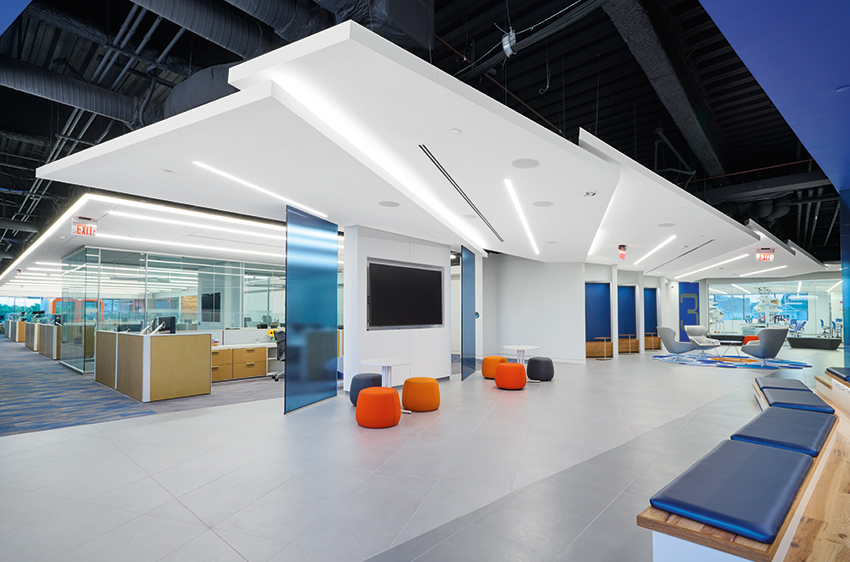
Photo courtesy of Armstrong Ceiling and Wall Solutions
In the past, ceiling systems have been an area of compromise between acoustics and a monolithic appearance. Now, a seamless acoustical drywall alternative, like this one constructed for biotech company REGENXBIO, provides a ceiling system that combines high-quality acoustics with a seamless aesthetic.
Why Acoustical Ceiling Systems?
Good acoustical design for a given space is a matter of finding the right combination of sound absorption and blocking by using several well-developed tools to balance the acoustic characteristics within that space.
Due to the science-based study of architectural acoustics, acoustical materials and products have advanced. Since product manufacturers provide all necessary testing and report the results, it is easier for architects, interior designers, and acoustical consultants to make better informed, more holistic decisions about many of the materials and products used in a space. This is particularly true when it comes to ceilings which have proven to be a key surface affecting acoustical characteristics of virtually all spaces. Selecting materials based on the needs of different types of spaces is also important and has been studied and investigated as well.
Sound heard within a space is born of a combination of direct sound from sources and sound reflected off the various surfaces within the space. Highly reflective surfaces will redirect sound without significant changes except for direction. Typically, in large “hard surface” rooms, the reflections can delay reaching a listener, creating echoes. On the other hand, a highly sound-absorptive surface will diminish the reflected sound waves and reduce reverberation and echoes. Based on these different interactions between sound and spaces (i.e., room size, shape and volume, and the acoustic treatments within or between spaces), people can experience differing levels of speech intelligibility, speech privacy, or unwanted sound intrusion.
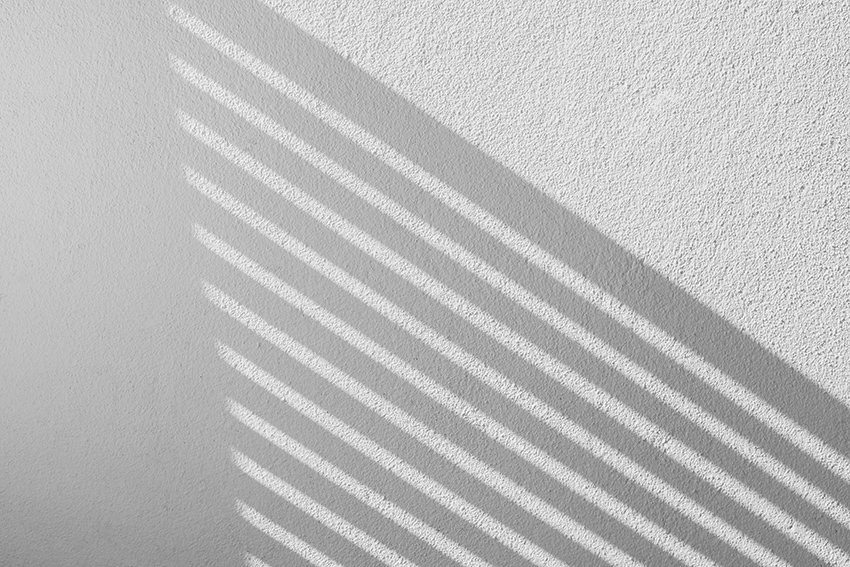
Stucco has gone through cycles of popularity, but it continues to be a desired material for seamless ceiling systems due to its fire and mold-resistant properties.

Stucco is applied as a smooth texture. It often has been used in open-space interiors, such as cathedrals, where its acoustics work well and its smooth texture can be utilized for frescoes.
Acoustics are an invisible element that designers must tackle, but they are often overlooked. As it turns out, acoustics are essential to the way occupants experience life inside a building and can significantly affect health, safety, and comfort. Considering a variety of venues such as hospitals, schools, retail, hotels, apartments, and offices, it’s easy to see how acoustics can directly impact occupants in a variety of ways.
In the past, ceiling systems have been an area of compromise. There is much more available today to meet the needs of architects looking for multifaceted systems that achieve more than one goal. While many projects have used traditional grid and ceiling tile design to their advantage and successfully made them a part of their interior design, many designers prefer a smooth, monolithic appearance with no visible grid when location allows. On the other hand, acoustical plaster—which has both a smooth look and beautiful aesthetics—is expensive, and some projects don’t have the budget for it.
This course provides an overview of what has been available to architects for smooth monolithic ceilings, including stucco, plaster, drywall, acoustical plaster, and a new technology system that combines drywall aesthetics with quality acoustics. Architects now have more options when designing for form and function; today they can achieve both while staying within budget. Although some spaces within a project require little more than a drywall ceiling, other spaces might call for investment in an acoustical drywall alternative that takes advantage of acoustical and drywall qualities without the high price tag of acoustical plaster.
For that reason, specifying ceiling systems is all about understanding the use of a particular space and taking into account the budget available. Here we talk about the pros and cons of each type of system, providing some history of the materials and their evolving uses over time.
Seamless Stucco
Stucco has a colorful and storied history as one of the oldest construction materials used by builders. It dates back as early as 1400 BC when it was used in Greece as a material for temples. Architects of ancient Rome used stucco for tombs and as a finish for brick monuments, such as for the opulent villa erected for Emperor Hadrian in Tivoli around 120 AD—a structure still regarded as one of the highest expressions of Mediterranean culture. As an interior material, it was used as an ideal seamless foundation for painted frescos and found even greater popularity during the Renaissance, beginning with the Italians, and spreading across Europe.
Traditional stucco was made of lime, sand, and water, but in the late 1800s, builders began to use stucco made of portland cement, sand, and water. Lime and other ingredients are sometimes added to the mixture to improve its structural properties, increasing permeability and workability. It involves up to four layers that include a dash coat, scratch coat, brown coat, and finish coat. Applying interior stucco finishes requires a special premeasured powder mix to which water is added before being sprayed on the surface.
Stucco has gone through cycles of popularity, but it continues to be a desired material for seamless ceiling systems for several reasons. It’s durable—resistant to fire, rot, impact, mold, and bug infestation—and it is capable of lasting up to 100 years or more depending on climate. Its ingredients can usually be obtained through local, sustainable sources, which puts it in the category of a “green” material. Aesthetically, its texture can provide an Old World-feel to the architecture of a room, which makes it both a building material and an architectural style. It has good color retention and pigments can offer a variety of colors for design. In terms of application, its high level of workability allows for a seamless look to interior ceiling systems.
Disadvantages of stucco include that it requires some amount of maintenance, including inspecting for cracks and holes that need to be addressed early on before they become a problem. Discoloration can also be an issue and not as easy to fix on interiors as it is on exterior stucco. Applying stucco is a specialized, labor-intensive process. It usually costs between $10 and $15 per square foot. And although stucco is flexible in application, it has a tendency to crack in areas where the building shifts over time. Finally, when stucco is not applied correctly, it can be prone to water retention, which leads to permanent water damage and, of course, added repair costs.
Additionally, stucco can provide some acoustic qualities, such as noise blocking, but it doesn’t provide any sound absorption, which is essential to proper use of interior space. It typically requires supplemental acoustical solutions to provide sound absorption depending on the use of the space.
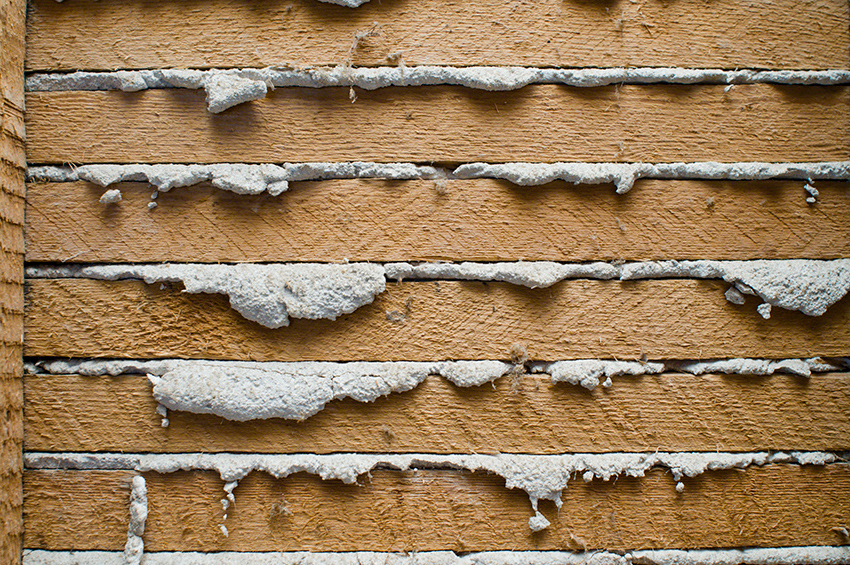
Lath and plaster is a traditional building process that uses narrow strips of wood, called laths, and plaster squeezed between the slats for fortifying the structure.
Seamless Plaster Ceilings
Plaster has been used broadly since antiquity. It contains the same materials as stucco: sand, water, and a binding material such as lime, gypsum, or portland cement (or some combination of those). Its earliest iterations featured mud and then, later, lime. Natural lime fell out of favor when portland cement became popular in the 1800s. Unlike stucco, plaster is applied as a smooth texture and is more often used in interiors. It creates a protective cover over stone and brick, but also offers a seamless, aesthetically pleasing finish. It’s a powdered mixture that is applied in two coats.
Lath and plaster is a traditional building process developed during the 17th century that once served as the standard to finish ceilings. Narrow strips of wood, called laths, are nailed horizontally across the joists or wall stud. Next, the laths are coated in plaster. The plaster squeezes between the slats and “keys” behind the slat to hold itself on the wall or ceiling, fortifying the structure.
One interesting ingredient in plaster in its early years was horsehair. It acted as a bridging agent, keeping the plaster from shrinking and making it more durable. Other animal hair was sometimes used, but horsehair from the tail made for the best mixture, because it is long and strong. Horsehair plaster was time intensive to apply, so when drywall was invented, it soon replaced horsehair plaster.
Plaster has several benefits. It has a durable surface that lasts a long time and can be painted over easily. It is mold-resistant and easy to clean, and thick plaster blocks sound well.
On the other hand, plaster does not provide good sound absorption. It is porous and can absorb moisture easily, which means you need at least a couple layers of paint to achieve the desired aesthetic. Once plaster cracks it is expensive and difficult to repair, often requiring removing a large portion of the material. It is generally more expensive to install than drywall. Owners should expect to pay up to $30 per square foot, which means it is not an ideal solution for every situation.
Seamless Drywall Ceilings
Drywall was invented by a major U.S. gypsum company in 1916 as a material to protect homes from urban fires. It was marketed as the poor man’s plaster and promised quick installation. It did not catch on right away. However, during the 1940s, it started gaining in popularity. Between 1946 and 1960, when more than 21 million new homes were built nationwide, drywall had become the system of choice because of its neat and tidy look. In a post-war world, the clean, monolithic style added a sense of security and calm the nation was looking for.
Drywall is made of gypsum mixed with water and spread between two large sheets of paper. Drywall comes in a variety of panel sizes and thicknesses for use in a variety of applications. The plasterboard is installed by lifting the pieces and attaching them to the studs. 5/8-inch-thick drywall panels are most commonly used in commercial ceiling applications to meet code requirements.
The key benefits of drywall include the fact that it is easy to paint over. It’s more stable than plaster, easier to repair, and less expensive to install. Moisture resistant drywall panels can be specified for installation in bathrooms.
Drywall is not as flexible as plaster and not as durable. Drywall provides good sound blocking performance in the correct thickness/assemblies, which provides adequate speech privacy, but does not absorb sound in a meaningful way – which leads to increased reverberation times, poor speech intelligibility, and overall poor acoustics.
Drywall ceilings have come a long way over the years. Pre-engineered drywall grid systems (DGS) can install three times faster than traditional track and channel framing. They offer a clean, smooth aesthetic in spaces that don’t require acoustical performance for speech intelligibility or noise reduction.

Drywall is made of gypsum mixed with water and spread between two large sheets of paper.
Previously, if a designer wanted the smooth, clean look of drywall in a space, it meant using drywall and sacrificing acoustics. In places like libraries, auditoriums, and schools, drywall can’t absorb enough sound in these areas. But choosing excellent acoustics often meant a grid and tile or suspended ceiling, or another material type that does not offer a smooth, seamless surface.
Seamless Acoustical Ceilings
Seamless acoustical ceilings have become a popular way of achieving aesthetics and acoustics all in one. There are several different kinds of systems that can be specified.
Two-Layer Acoustical Systems
Acoustical plaster is a two-layer system that consists of fiberglass panels that are attached to a drywall substrate with adhesive. The face of the fiberglass panels are hand-troweled with an acoustically transparent finish that achieves goods soundproofing, speech intelligibility, and privacy. Applications include museums, auditoriums, libraries, galleries, performing arts centers, mid- to high-level retail locations, transportation hubs, high-end residential homes, educational facilities, and conference rooms. It has the ability to absorb and dampen sound, reduce echoes and reverberation, and prevent noise transference between rooms. It is monolithic and can be finished in almost any color. Its cost is on the higher end, however: Usually between $35 to $50 per square foot depending on job complexity.
Acoustical drywall is a two-layer system that can be installed on flat, curved, or vaulted surfaces and allows for exploration of color. The perforated sheetrock optimizes acoustical performance by allowing sound to enter the holes and be absorbed by a mineral wool layer. The system has a high, light-reflective finish and reduces fixture and energy use. It installs and repairs similarly to standard drywall. It also integrates well with lighting and HVAC fixtures and is less than half the cost of acoustical plaster systems. The cost for this type of system is usually about $30 to $35 per square foot.
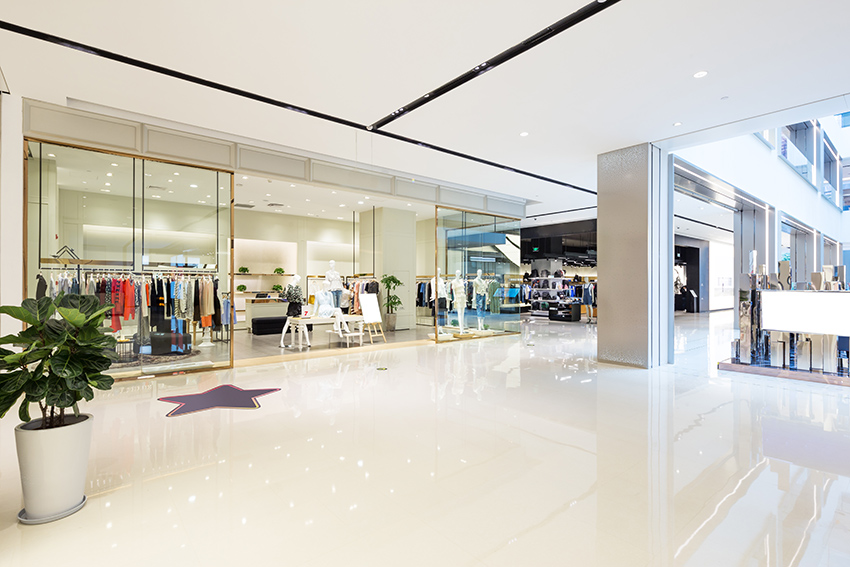
Two-layer acoustical drywall has a high, light-reflective finish and installs and repairs similarly to standard drywall.
Single-Layer Seamless Acoustical Drywall Alternative Ceilings
The latest iteration of seamless acoustical ceiling systems utilizes a one-layer system. Like the two-layer systems, it features a smooth, non-directional, monolithic aesthetic that meets—and often exceeds—the standards of architects, designers, and owners who are looking for a clean drywall appearance combined with effective acoustical performance.
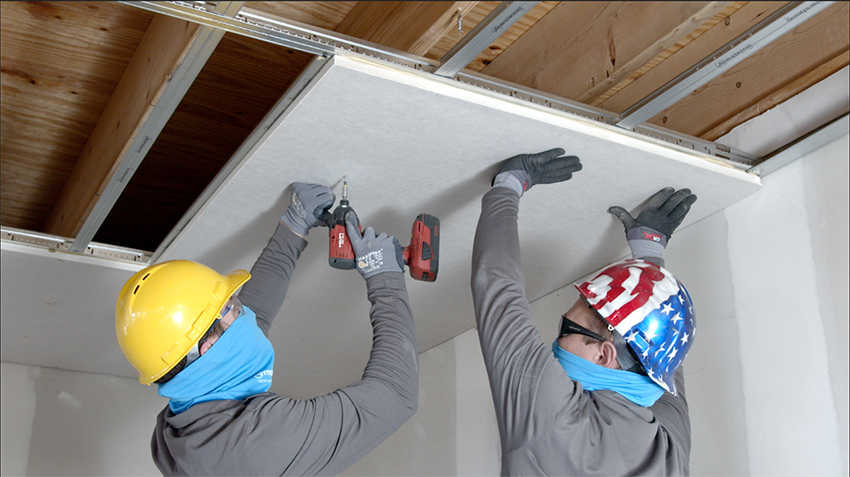
The primary advantages of new single-layer seamless acoustical drywall alternative ceiling systems are that it costs less and is faster to install than acoustical plaster.
An acoustical drywall alternative is easier to install than plaster and can be installed on ceilings in a variety of applications. Panels are lightweight—far lighter than drywall and easier to handle on the jobsite and install. Panels install similarly to drywall, with some nuances that include thicker panels. A seamless acoustical drywall alternative manufacturer can provide extensive, hands-on training for installation teams so they are capable of installing with confidence.
Seamless acoustical drywall alternative ceiling installation begins with the installation of a compatible DGS, which is squared within the module. The panels are installed next—parallel to the main beams—followed by the joint compound. Before spraying the acoustically transparent finish, inspect the ceiling for defects that need repair. Once that’s done, you will need to spray with equipment that can atomize the finish. This will allow sound to pass through the finish into the board to be absorbed.
The biggest advantage of this acoustical drywall alternative is that it is a one-layer system, and therefore costs less than acoustical plaster. There is a common misconception that great acoustical performance requires a two-layer system. In the case of a seamless acoustical drywall alternative system, only one layer is necessary at $25-$30 per square foot, which means a project can save time and money due to the lower cost of installation. It also can be patched or repaired, as needed.
As we’ve learned, the evolution of ceiling systems is driven by a desire for better efficiency and lower costs, while still providing high-performance features. Architecture has evolved over the years as architects and designers have come to understand the impact of design on health and well-being. Stucco and lath and plaster evolved into drywall. Two-layer acoustical systems have taken it a step further to achieve the once unheard of idea that clean monolithic lines and acoustics could be combined. The one-layer acoustical drywall alternative ceiling system is a next step in the aim for innovation, and a solution that helps to reduce material usage and installation cost while improving sustainability.
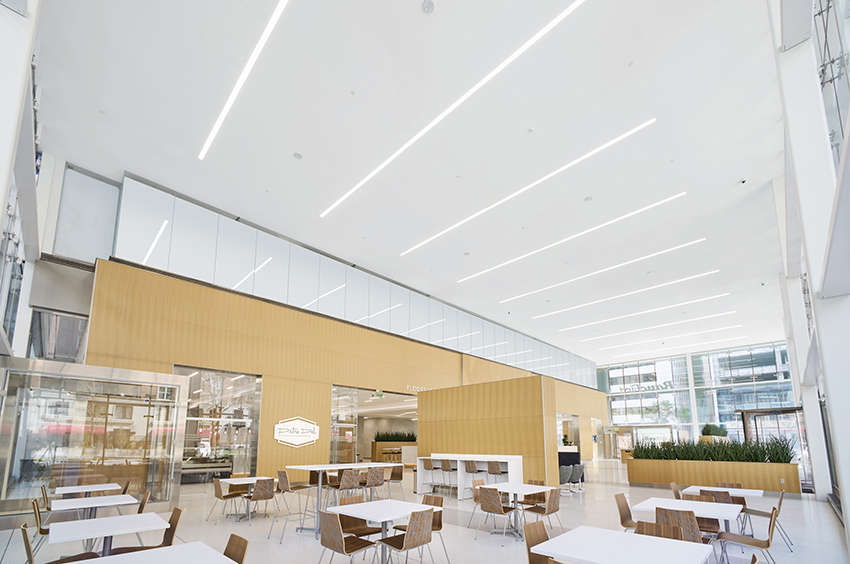
Photo courtesy of Armstrong Ceiling and Wall Solutions
A single-layer seamless acoustical drywall alternative is able to achieve the goal of indoor environmental quality in which acoustics and aesthetics are key to occupant health, safety, and well-being.
Indoor Environmental Quality For Occupant Well-Being
In the simplest of terms, indoor environmental quality (IEQ) is the quality of a building’s environment in relation to the health and well-being of its occupants. It includes design that keeps in mind elements such as air, light, acoustics, temperature, sustainable materials, and aesthetics. And as simple and obvious as these elements seem, when you start to think about the ripple effect of how they impact occupants in a building, it becomes clear how complex and crucial IEQ is to every human in every indoor space. The spaces we occupy have a critical effect on our physical and mental health. They influence the quality of the decisions we make, the way we feel, how we move in the world and interact with others, and how well we accomplish work and other daily tasks. In other words, spaces affect the way we experience our lives. And in the United States, where people spend about 90 percent of their time indoors, that impact is no small matter.

Photo courtesy of Armstrong Ceiling and Wall Solutions
In offices and lobbies, acoustics are a key aspect of ceiling and wall systems in which the balance between in-room sound and room-to-room sound is important.
Indoor air quality (IAQ) has long been a focus in the architecture, engineering, and construction industries because it is critical to the U.S. Green Building Council's LEED green building rating system, which considers issues such as volatile organic compounds (VOCs) and other pollutants. Many construction projects strive for green building rating systems because they add value to their project, signal a commitment to sustainability and ethical construction, and keep designs on the cutting edge.
But the goal of IAQ is no longer enough. A holistic approach is now considered foundational to building design, which is why, over the last few decades, IEQ has become the gold standard. Beautiful, inviting public spaces designed to make people feel good is critical to the health, safety, and well-being of building occupants. This newer ceiling category—the seamless acoustical drywall alternative—accomplishes this goal. The following section delves into the importance of minimizing intruding noise by way of acoustic ceiling systems.
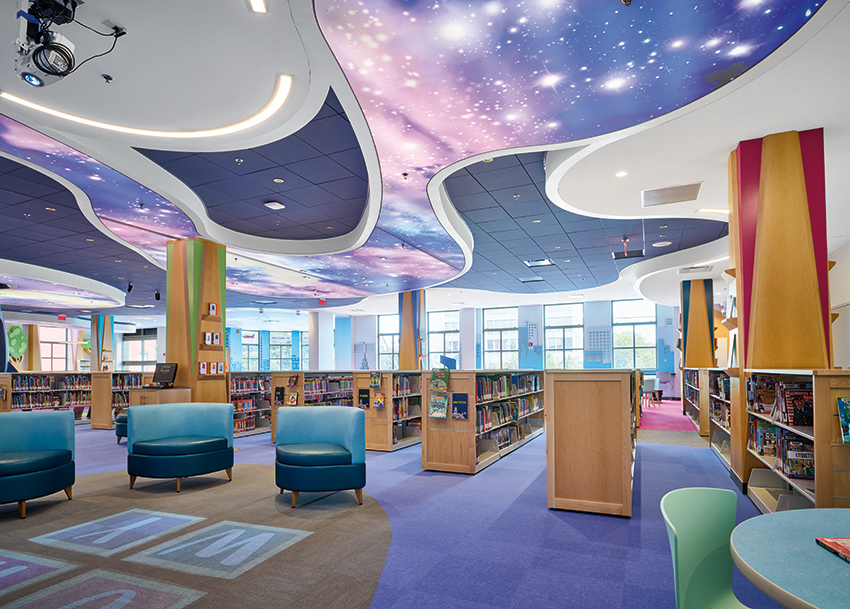
Photo courtesy of Armstrong Ceiling and Wall Solutions
The Worcester Public Library in Massachusetts is an example of how a seamless acoustical drywall alternative combines function and design in a space where acoustics and visual artistry are both highly desired.
Why Acoustics Matter for the Occupant
Acoustics are an important aspect of ceiling and wall systems in which the balance between in-room sound (comfort and speech intelligibility) and room-to-room sound (isolation and speech privacy) is important. This impacts spaces such as open offices, college lecture halls, libraries, and boardrooms, as well as hotel lobbies and ballrooms that often hold conferences and other events.
It plays a key role in offices, for instance, where well-designed spaces allow workers to concentrate on the task at hand, which leads to better productivity. Poorly designed spaces, on the other hand, lead to distraction, discomfort, and dissatisfaction for workers, decreasing productivity in the office and even negatively affecting their lives outside the office. For employers, productivity is important to the design of a space because people are the biggest cost when it comes to running a business, and retention of happy, healthy talent is imperative.
In some cases, workplace noise can be such a hazard that workers suffer adverse health effects. According to the Institution of Occupational Safety and Health, the health effects can be caused by either a single exposure to very loud noise or exposure to raised levels of noise over long periods of time. The effects depend on many factors, such as pitch and sound pressure, and personal health qualities such as lifestyle, age, and genetics. But the negative results can include hearing loss, anxiety, irritation, increased blood pressure, and other physiological and mental health issues.
When comparing the acoustic qualities of seamless acoustic ceiling systems, Noise Reduction Coefficient (NRC) and Ceiling Attenuation Class (CAC) are two measurements to take into consideration.
NRC is the rating of how much sound a material can absorb. It is measured on a scale that ranges from 0.00 to 1.00. For example, an NRC of 0.00 means the product absorbs no sound, and an NRC of 0.80 means that 80 percent of the sound that hits the material is absorbed.
CAC is the rating of a ceiling system as a barrier to airborne sound transmission between adjacent closed spaces that share a common air plenum. The higher the CAC rating, the better the performance. CAC (for ceilings) and Sound Transmission Class (STC)(for walls) are the exact same value, the only difference is the specific path. Optimal design will “match” wall STC and ceiling CAC. For example, a wall or ceiling with an STC 40 and CAC 40 will reduce sound by approximately 40 decibels (dB) when it passes through a wall or ceiling assembly.
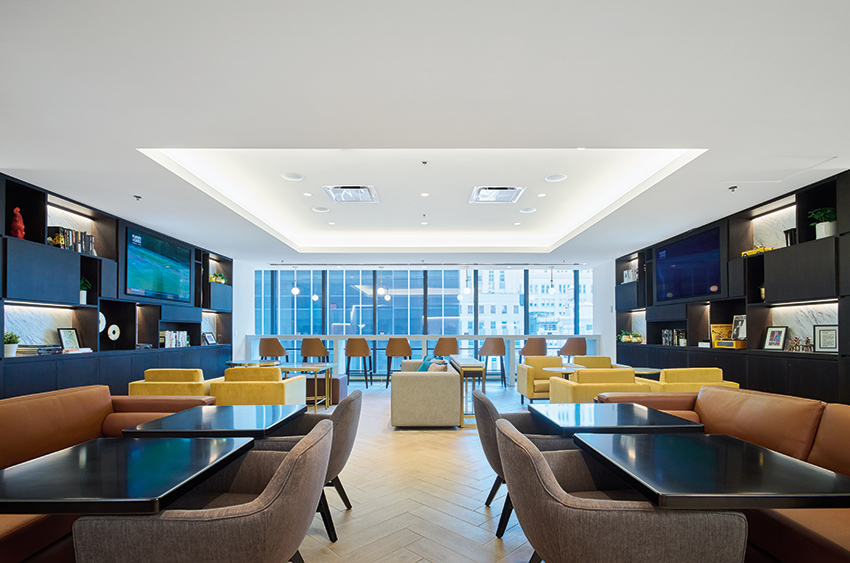
Photo courtesy of Armstrong Ceiling and Wall Solutions
The seamless acoustical drywall alternative integrates well with a variety of lighting systems.
Most acoustical plaster has an NRC between 0.85 and 0.95, making it highly absorptive in comparison to other systems. Painted drywall, on the other hand, has an NRC of about 0.05, so it only absorbs about 5 percent of the sound that hits it, while reflecting back 95 percent. Seamless acoustical drywall alternatives feature a combination of high sound absorption and high sound blocking, all in one. That system controls “in-room” sound quality with an NRC of up to 0.80, which means it absorbs up to 80 percent of the sound that hits it. It controls “room-to-room" sound isolation with an extremely high CAC of up to 46, making it a “match” for STC 45 to STC 50 wall assemblies. This means it has the ability to support private conversation by not allowing sound to enter adjacent spaces.
It should be noted that all these acoustical systems require acoustically transparent finish since it is the board itself that absorbs the sound.
New single-layer acoustical ceiling systems can go on walls above 7 feet. With these wall assemblies, it’s important to consider STC which calculates the effectiveness of a product in reducing sound transmission between rooms. The higher the STC rating, the more effective that product is in reducing sound transmission. An acoustical drywall alternative ceiling system can improve the rating of interior stud and drywall partition systems by 6 points, which can make a big difference.
The seamless acoustic drywall alternative was developed to be flexible enough to provide solutions for a variety of spaces. It provides the clean, monolithic visual of drywall with excellent acoustical performance and sustainability attributes along with efficient installation in a wide variety of applications.
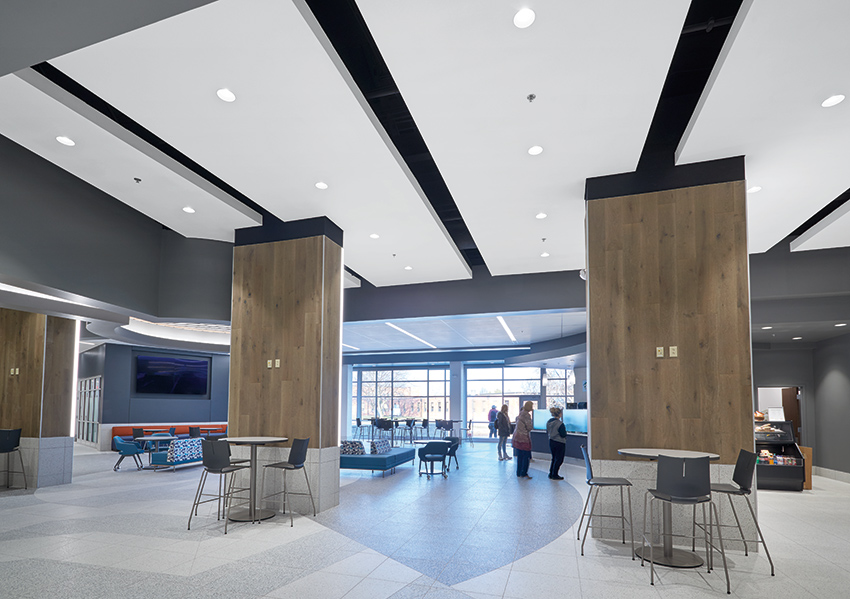
Photo courtesy of Armstrong Ceiling and Wall Solutions
Large format, seamless acoustical ceiling clouds add visual impact and acoustical performance in large, open entry spaces, such as this area inside Vincennes University in Indiana.
Why Aesthetics Matter for the Occupant
Aesthetically pleasing architecture is not just about appreciation of beauty. A well-done design combines aesthetics and functionality in a way that can evoke positive feelings for occupants. These feelings enhance health and wellness, which is why the “Beauty and Design” feature of the WELL Building Standard is a requirement for all projects—aesthetic intention is integral to the quality of an occupant’s experience.
As with acoustics, aesthetics impact the way people live, work, learn, heal, and play. On one hand, if it’s inadequate or thoughtless, a building’s lack of a good aesthetic can make an occupant feel anxious or depressed. Yet when it’s working well, it can provide just the right space for a student in a university hall to begin to understand their passion for philosophy or mathematics. It can inspire workers to be present and solve problems in ways that lead to better innovations for a company. It also can be a way to signal the values of an organization to their employees or the public.
Health and Safety Profile
A high-quality acoustic drywall alternative meets the material and IEQ requirements of LEED, the WELL Building Standard, Fitwel, and Living Building Challenge. It has a Declare label showing it is free of Red List chemicals per the Living Building Challenge 4.0, a Health Product Declaration (HPD) that tells you what is in the product, and EPD (Environmental Product Declaration) detailing its carbon footprint. This product is listed in Mindful Materials and the Embodied Carbon in Construction Calculator (EC3) tool.
Sustainability Profile
As the built environment continues to grow globally, climate change calls for smarter, more sustainable approaches to building construction and material choices.
Twenty-eight percent of global emissions are from buildings in the form of operational carbon—the energy used to power, heat, and cool a building. A building’s operational carbon can be reduced through energy efficiency measures. Changes made by policymakers, architects, developers, and engineers have significantly advanced these measures. The remaining 11 percent of global carbon emissions attributed to building construction are generated from building materials and construction in the form of "embodied carbon" which can account for half of the total carbon footprint over the lifetime of a building.
For this reason, specifying systems with high sustainability profiles is imperative. When selecting a seamless acoustic ceiling system, it should meet stringent sustainability compliance standards, including LEED v4 and 4.1. The new acoustical drywall alternative consists of recycled materials, and it meets the Living Building Challenge, which is the most rigorous performance standard for buildings that “give more than they take” and are free of Red List chemicals. It should also provide a Health Product Declaration (HPD), which can tell you what is in the product, as well as being UL Greenguard Gold certified.
The idea is to support products that create a positive impact on the human and natural systems that interact with the building. Products that meet this standard are self-sufficient and sustainable, staying within the resource limits of their location. Manufacturers should be given preference when they provide documentation to support sustainable features.
Applications For The Acoustical Drywall Alternative
The seamless acoustical ceiling is becoming a common replacement for drywall. It is an alternative that can be used in almost any application where drywall is used and whenever acoustical performance is important.
Applications
A seamless acoustical ceiling system can be applied as an alternative to drywall in wall-to-wall, sloped, soffit, or cloud ceiling applications, as well as in wall applications above 7 feet. It is intended for spaces desiring a Level 4 equivalent drywall finish. Like Level 4 drywall, critical or low-angle light grazing across the ceiling can show imperfections. Ceilings are an excellent place to apply seamless acoustic systems, because the material can create better lit areas by enhancing daylight thanks to the 0.87 light reflectance value of the finish.
The acoustical drywall alternative can work well in wall-to-wall applications and can integrate with technologies that create horizontal and vertical separations in the walls for easy transition between walls and ceiling. It also can integrate with framing systems for easy soffit construction.
The gravitation toward open spaces in offices and other shared, flexible spaces are challenges when it comes to acoustics. One application that works well for the acoustical drywall alternative is ceiling clouds—a popular ceiling type that is made of ceiling panels that help absorb sound and control acoustics in these types of spaces. They are also aesthetically appealing, providing visual detail that can be arranged according to the design of the space.
Seamless acoustical ceiling clouds are suspended from the ceiling individually and can be designed in almost any shape, with or without integrated lighting. These clouds are ideal in exposed structure spaces because they can add acoustic and aesthetic appeal while absorbing sound on both the front and back surfaces if designed with acoustical infill material added to the back of the cloud.
Aesthetic Compatibility
White is the most common ceiling color for acoustical drywall alternative, however light color tones are available. There is not a lot of flexibility when it comes to darker colors. Design trends that use multiple materials for ceilings in single and adjoining spaces continue to be on the rise, and the acoustical drywall alternative is able to integrate with—and complement—materials such as wood, metal, and felt to provide the mixed-material aesthetic.
Seamless Integrations For Acoustical Ceiling Systems
Acoustical ceiling systems that have the smooth look of drywall can be integrated seamlessly with lighting and other features the same way as a drywall ceiling. They accommodate light fixtures, HVAC grille, floating trim, shade pockets, HVAC return air plenum, access doors, and transitions to standard acoustical ceiling systems. The system’s finish can be used to coat most GRG or metal access panels/doors in order to maintain a consistent finished-ceiling visual.
These pre-engineered, integrated solutions not only make specification easy but also allow fast and easy installation by removing the guesswork. The ceiling and components are specifically designed to work together as a system, yielding a variety of benefits.

Photo courtesy of Armstrong Ceiling and Wall Solutions
Ceiling systems provide a first impression to anyone entering the room and can affect the way people experience their interactions with others inside the space.
Integration with Lighting Systems
The seamless acoustical drywall alternative integrates well with a variety of lighting systems, from energy efficient LED lighting to luminaires. For instance, it can integrate with lighting designs for high ceilings, zero plenum interference, and on-center continuous or noncontinuous linear lighting layouts.
These types of ceilings can be installed with most compatible light fixtures or diffusers, but it is still important to select those that will specifically integrate with the system. It’s crucial to select fixtures than can accommodate 7/8-inch-thick ceiling panels. Also of note: Excessive ceiling integrations and/or small enclosed spaces where the ceiling is more joint compound than open area will result in degradation of sound absorption.
Integration of In-Ceiling UV-C Air-Cleaning Systems
UV-C air-cleaning systems have become more popular and have seen more development over the past year and a half since the first U.S. shutdowns due to the pandemic in early 2020. As people return to work, systems that can proactively fight pathogens have become not just a stopgap between pandemic times and “normal” times, but a solution for the long term. Building owners must come to accept the idea that prevention is key and understand that technologies that can clean the air are now essential to help reduce the transmission of certain viruses, bacteria, and allergens.
Tests have proved that high-quality, UV-C air-cleaning technology reduces the transmission of certain viruses, bacteria, and allergens. In some cases, simulation studies have shown UV-C air-cleaning systems reduce bacteria by more than 20 percent and reduce inhaled particle concentration by 22 percent in comparison to rooms with no air filtration.
Acoustical drywall alternative ceiling systems integrate well with certain UV-C air-cleaning systems. Ceiling units can be concealed and installed out of the way. In tests, in-ceiling placement of air-cleaning technology outperforms air-cleaning units placed on the floor. In one simulation study, the in-ceiling unit reduced particle concentration by 14 percent more than traditional floor units.
Seismic and Other Movement Features
Seismic design is an essential part of the structural analysis when designing a building. Seismic design features can help preserve a building during and after it experiences an earthquake. It’s an aspect of design that has evolved over time and is now a basic component of integrated systems, including ceiling systems.
Drywall grid systems that support the seamless acoustical ceiling systems have been tested and are approved for use in seismic design categories D, E, and F. Seismic D corresponds to buildings and structures in areas expected to experience severe and destructive ground shaking, but not close to a fault. Seismic E refers to buildings in areas near major active faults. Seismic F corresponds to buildings of occupancy groups in hospitals, police stations, and emergency control centers near major active faults.
Seamless acoustical ceiling systems also integrate with control joints to help relieve stress induced by small movement from absorption or expulsion of moisture. Control joints are required and follow the same guidelines used for drywall in ASTM C480 Section 20. The ceiling systems integrate well with expansion joint systems, too, which are integral to seismic design and handle small and big impacts from movement from moisture to earthquake activity.
Access Doors
Plan for access doors just as with drywall or move the item that needs service access to another area that has acoustical ceiling tile so the item is accessible. Specifying clouds can also provide open access areas to the plenum between the clouds.
Soffits
One significant misperception about seamless acoustical ceilings is that they are more limiting than drywall in terms of options. In fact, these systems are capable of very complex soffit designs using a prefabricated soffit framing system that quickly clicks into shape and installs faster and easier.
Conclusion
Since the early Neolithic settlements, architecture has offered a range of evolving solutions to an endless number of structural and aesthetic design problems. In this article we have learned that the desire to balance form and function sometimes takes a breakthrough technology that had never before been imagined. Ceiling systems inside a building provide a first impression to the occupant but can also come with hidden costs and benefits that are unseen, like acoustics. Until recently, architects that wanted a smooth seamless ceiling could not get function (acoustics) at a reasonable cost. An acoustical drywall alternative is part of a sea change in the world of ceiling systems. In a time when IEQ—which embraces both aesthetics and acoustics as priorities for health and well-being—has become a basic tenet for design consideration, this kind of system is a logical step in the evolution of ceiling systems.
Armstrong World Industries is a leader in the design and manufacture of innovative commercial ceiling and wall systems. At home, at work, in healthcare facilities, classrooms, stores, and restaurants, Armstrong Ceiling & Wall Solutions offer interior options that help create healthy, sustainable spaces that protect people and cultivate well-being and comfort so they can be at their best.
Armstrong is committed to developing new and sustainable ceiling solutions, with design and performance possibilities that empower its customers to create beautiful, high-performance residential and commercial buildings. Armstrong continues to grow and prosper for the benefit of all its stakeholders. armstrongceilings.com/commercial
Declare® is a registered trademark of International Living Future Institute®; Living Building Challenge®, WELL™ and WELL Building Standard™ are trademarks of International WELL Building Institute; LEED® is a registered trademark of U.S. Green Building Council; REGENXBIO® is a registered trademark of REGENXBIO, Inc.; UL® is a registered trademark of UL LLC; all other trademarks used herein are the property of AWI Licensing LLC and/or its affiliates.
© 2022 AWI Licensing LLC
Erika Fredrickson is an independent writer and editor focusing on technology, the environment, and history. She is a frequent contributor for continuing education courses and publications through Confluence Communications. www.confluencec.com













